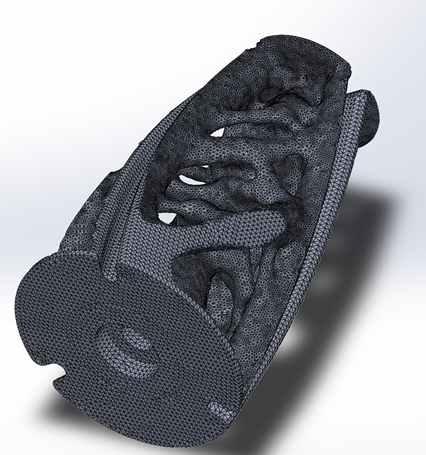Organic Desk Fountain Update
Since I have had my Final Project in mind for quite a while, my plans for it are generally locked in. Because of this I won’t go to far into alternatives for my project but instead will highlight the progress I have made so far.
As I described in my fifth blog post, I plan to make a Desk Fountain inspired by the Organic Aesthetic. Specifically, the view you get when looking up a tree. The figure below shows this target affect for my project.

Figure. 1 Upward View of a Tree
To achieve this highly unique and complex structure in my Final Project, I am using the SolidWorks tool Topology Optimization. This tool strategically takes out material that is not holding a relatively high amount of stress from an applied load. Simulations using Topology Optimization at its highest setting take multiple hours which ended up making this process take multiple days of work.

Figure. 2 Simulation
The model in the image above is basis for what the Topology Optimization tool takes away from. There is a channel throughout the middle of the component for water to be pumped up though and then grooves down the side of the part for water to flow down. I am using a bearing at the bottom of this piece where hopefully in the absence of friction and the water flowing at an angle down the side will cause the whole thing to spin. The figure below shows a cross section of my design for the fountain:

Figure. 3 Fountain Cross Section
Below the top component of the fountain, a dish is present to capture the water as it falls. It also acts as the interface for the tubing of the pump. This dish sits on top of a simple wood box to emphasize the tree inspiration.
While it is often difficult to get a visually appealing output of a Topology Optimization Simulation. Balancing manufacturability and holding true to my inspirations was tricky. I managed to get it right after ten tries. The figures below show off the crazy organic structure:

Figure. 4 Topology Output Side View

Figure. 5 Topology Output Bottom Isometric View
In these figures, each small triangle is an element in the Finite Element Analysis used in Topology Optimization. The only way to really manufacture components like this is 3D Printing with a lot of infill. Even then, the surface finish is lackluster. For this issue, I plan on buying some PLA sealant. This should smooth out the final 3D Print of the Topology Optimized structure and provide a nice shine.
Picture 1: https://i.pinimg.com/originals/cf/ef/fd/cfeffd2d1fe846e5e499a48671a2d6ac.jpg
Picture 2: Original Content
Picture 3: Original Content
Picture 4: Original Content
Picture 5: Original Content

4 Comments. Leave new
Hi Branden, thanks for your comment. I appreciate your kind words and this PLA sealant is new to me as well. It only cost about $20 and is a two part mixture similar to epoxy that creates a large exothermic reaction. This melts the surface layer of the print and bonds everything together while curing with a smooth glossy finish.
Hey Michael,
I really like your idea and think it definitely reflects organic forms. One thing I do like a lot is your juxtaposition between the organic inside and the sweeping lines on the outside. I can imagine that the sealant will be tough with how intricate your structure it, so I would be prepared to spend a lot of time sanding and finishing. One thing that might be cool to consider is making spaces for strategically placed LEDs to illuminate the inside and show off the texture of your organic forms. What are you considering for colors?
Hi Joshua, thanks for your comment. I definitely think that the finishing of the 3D Printed components will take the longest amount of time of everything for the project. I think your idea on lighting is really important because I don’t want any of the internal structure to be lost in shadows. To address this I was planning on either using white or a light grey. The box will be made out of wood to emphasize further the organic form inspired by a tree.
Hey Michael!
This is such a cool and unique project! I am blown away at the features SolidWorks has and how good your topology has turned out thus far. Similar to you, I have had my design pretty much cemented for weeks so I didn’t discuss alternating aesthetics too much. I agree infill will be your best friend when printing this project and I was not aware of PLA sealant. Is this sealant expensive and does it make a mess when painting it onto your final project? Anyway, I can’t wait to see how this turns out!